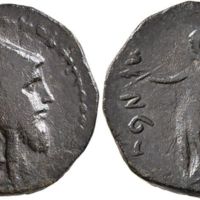Artabanus - AE 4 chalkoi - Apollo
Identifier
Kovacs-unlisted; ANRO-887
Reference Description
Artabanus c. 202 BC ?
AE 4 chalkoi
Obv. Bearded and draped bust of Artabanos (?) to right, wearing bashlyk with fanion and lappets folded up and tied with a diadem.
Rev. Apollo standing left, holding arrow in his right hand and leaning left on tripod.
AE 4 chalkoi
Obv. Bearded and draped bust of Artabanos (?) to right, wearing bashlyk with fanion and lappets folded up and tied with a diadem.
Rev. Apollo standing left, holding arrow in his right hand and leaning left on tripod.
Recent Sales
| Auction | Date | Characteristics | Realized | ||
| 1 | Leu 11 Lot 152 | 13-May-2022 | 21mm, 6.49g, 11h | CHF 9,500 | PHOTO |
Notes
Unpublished and unique. A highly important discovery and of the greatest numismatic interest.
The emergence of this fascinating coin is as exciting as it is puzzling. Clearly reminiscent of the unique coin of Artabanos sold in Leu Web Auction 16 (2021), 1180, it differs not only in size, being a tetrachalkon instead of a chalkous, but also in its use of Aramaic rather than Greek legends. This, in of itself, is not unusual, for other Armenian kings, such as Mithradates and Artaxias, also used both languages on their coins. However, the reading of the Aramaic on our coin is exceptionally difficult. It has been suggested to this cataloguer, in a private discussion with a linguist, to read hn\' bṭḥn\', which translates as \'this is bthn\'. However, no such name appears in the historical record, and neither would one expect to read \'this is ...\' placed in front of a royal name where mlk\' = \'king\' would normally appear.
Having said this, the similarities with the coin of Artabanos are too obvious to be ignored. Not only is the portrait remarkably similar, the coin also uses the same Apollo reverse derived from the Seleukid coinage of the later 3rd and 2nd centuries BC. Furthermore, the emission of coins with Aramaic legends alongside issues with Greek inscriptions mirrors the coinages of Artaxias and Mithradates and would thus entirely be in line with the habit of these slightly later Armenian rulers. Thus, rather than inventing a new king based upon a mostly unreadable inscription, our best guess, for the time being, is to assume that this, is in fact, the third known coin of Artabanos, as well as the first of this size and with an, albeit somewhat blundered, Aramaic inscription. It is undoubtedly a remarkable discovery and of utmost importance to the study of early Armenian coinage.
The emergence of this fascinating coin is as exciting as it is puzzling. Clearly reminiscent of the unique coin of Artabanos sold in Leu Web Auction 16 (2021), 1180, it differs not only in size, being a tetrachalkon instead of a chalkous, but also in its use of Aramaic rather than Greek legends. This, in of itself, is not unusual, for other Armenian kings, such as Mithradates and Artaxias, also used both languages on their coins. However, the reading of the Aramaic on our coin is exceptionally difficult. It has been suggested to this cataloguer, in a private discussion with a linguist, to read hn\' bṭḥn\', which translates as \'this is bthn\'. However, no such name appears in the historical record, and neither would one expect to read \'this is ...\' placed in front of a royal name where mlk\' = \'king\' would normally appear.
Having said this, the similarities with the coin of Artabanos are too obvious to be ignored. Not only is the portrait remarkably similar, the coin also uses the same Apollo reverse derived from the Seleukid coinage of the later 3rd and 2nd centuries BC. Furthermore, the emission of coins with Aramaic legends alongside issues with Greek inscriptions mirrors the coinages of Artaxias and Mithradates and would thus entirely be in line with the habit of these slightly later Armenian rulers. Thus, rather than inventing a new king based upon a mostly unreadable inscription, our best guess, for the time being, is to assume that this, is in fact, the third known coin of Artabanos, as well as the first of this size and with an, albeit somewhat blundered, Aramaic inscription. It is undoubtedly a remarkable discovery and of utmost importance to the study of early Armenian coinage.
Collection
Citation
“Artabanus - AE 4 chalkoi - Apollo,” Armenian Numismatic Research Organization, accessed January 22, 2025, https://armnumres.org/items/show/887.


